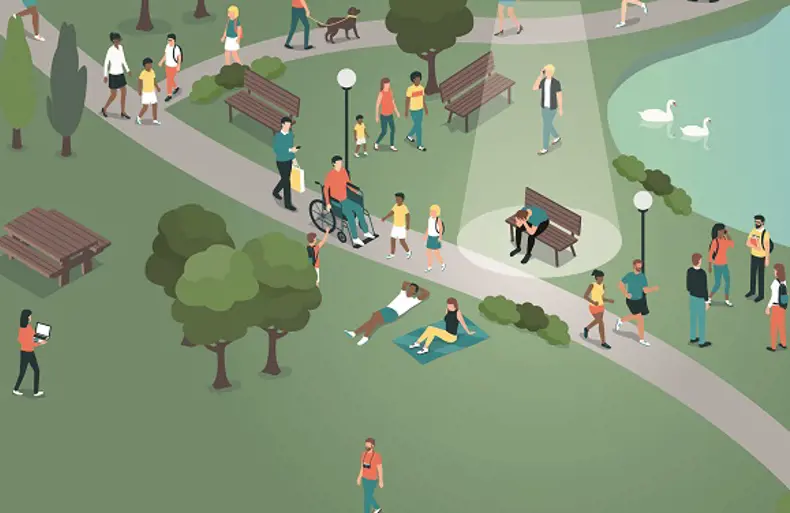Blog | Student Housing
Wellbeing-led design should be at the core of today’s student housing

Wellbeing / mental health
Wellbeing today is more than just a tick box; it is at the forefront of leading employer agendas, building design and is now considered a social norm. We are more aware today of the importance of mental health and associated conditions due to advances in technology and medicine and prominent campaigns such as Heads Together led by the Duke and Duchess of Cambridge and Prince Harry. It is now more widely accepted that #ItsOkToNotBeOk.
It is therefore not surprising that we now know that 1 in 4 people experience mental health problems each year. However, the growing number of students with mental health difficulties is alarming. On average, five times more students are disclosing mental health issues compared with 10 years ago and there are calls for this to be addressed.
How is property linked with wellbeing?
The World Health Organization reports that people in Europe spend over 90% of their time indoors (what else do you expect with the great British weather…). This is why buildings impact our mental and physical wellbeing massively. Studies have shown that access to open and green space improves productivity and mental health. Whereas collaboration space encourages social relationships, which is one of the primary functions to human health and wellbeing.
These concepts are promoted through assessments and certifications such as the international WELL certificate, BREEAM and through the planning framework via planning design and access statements. The International WELL Certification promotes health and wellbeing through the built environment; key considerations include air, light, fitness, water, nourishment, comfort and mind.
As a result of our improved understanding of the relationship between mental health, wellbeing and the physical environment, wellbeing is shaping the design of developments and the amenities they offer. We are already seeing this change in product design through the evolving build to rent sector.
Why are more students suffering from mental health problems today?
Students have always had the adjustment of leaving home for the first time, especially for overseas students who are adapting to a new culture. In recent years there has been a shift in students largely residing in PBSA rather than HMOs, which has resulted in a loss of ‘social glue’ generated from living in a shared house. Whilst increases in university fees since 2012 has added to student debt.
There is also more pressure for students today, who have to deal with the challenges that come with digital life and an increasingly competitive career ladder.
Student accommodation – getting it right
Student accommodation providers mustn’t ignore the rise in mental health issues and recognise the implications of the design of the accommodation. Rooms are getting smaller (within the requirement of 30 sq. m for a studio) and we are now seeing ‘micro student housing’ becoming more common.
So, how can student housing help support wellbeing and mental health?
- Open and green space – communal gardens or green areas, courtyards, trees and flowers.
- Indoor air quality – ventilation and circulation systems, openable windows and access to outside space.
- Social and inclusive design – enabling students to socialise through collaboration and social space such as coffee shops (students love coffee!), games rooms, group study rooms, cinemas and bars. Operators could organise events throughout the year, particularly in the opening weeks of the academic year, making it easier for shy students to integrate in their new environment.
- Light – installing high and large windows.
- Space – internal layouts should be open plan as much as possible whilst more collaboration and communal space should be provided in micro housing.
- Wellness – physical wellbeing space isn’t a necessity but if included, (as outlined in my last blog) they must be done well; basic gyms aren’t the answer. Physical health can be better encouraged via bike racks, sports activities and fitness studios and even relaxation areas such as saunas or steam rooms.
The future
The value of property for developers and investors is in the success of the occupier willing to pay higher rent and stay longer in return for a good quality product. This is evident in my experience in student schemes that are well designed; I am seeing current tenants rebooking for the following academic year. I have seen retention rates of around 25%, which for PBSA used to be unheard of.
As room sizes are shrinking, it is important common areas are provided with dedicated wellness space designed for social interaction.
Related Insights

April Residential Auction raises £43m amid signs of growing confidence in the market
Residential Auction Team raises £43m in April auction amid signs of growing confidence in the market

Allsop Commercial Auction Team releases May catalogue with a focus on London
There is a strong theme of London lots, including a portfolio of 13 shops and residential property in north London being offe...

Five things to consider when your new rates bill arrives
Five things to consider when your new rates bill arrives

Allsop raises £238m in auctions in first quarter following £55.8m March residential sale
Allsop, a leading property consultancy and the UK’s largest property auction house, has raised £55.8 million through the sale...